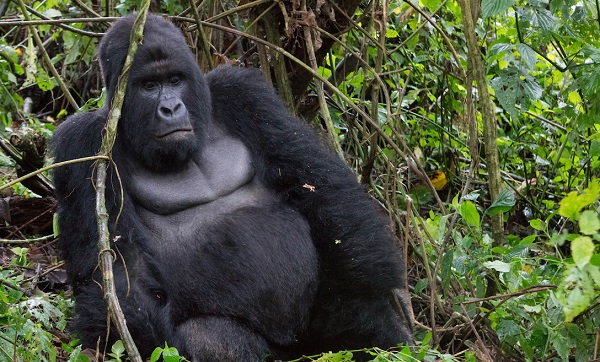
Rumangabo, DR Congo | AFP |
A powerful combination of love and guns is helping rebuild an endangered gorilla community in the jungles of war-torn eastern Democratic Republic of Congo.
Threatened with extinction, some of the world’s last remaining mountain gorillas live on either side of the border between Rwanda and DR Congo, as well as in Uganda.
On the Rwandan side, they live in relative security. But over the border in the Virunga National Park, Africa’s oldest nature reserve, they face the same threats as their human neighbours: armed violence which has ravaged the province of North Kivu for over two decades.
Armed groups prosper in the park thanks to trade in charcoal, burning swathes of equatorial forest every year in the heart of the mountain gorillas’ natural habitat.
The immense simian primates are also victims of networks of poachers who hunt baby gorillas to sell as pets in Asia, regularly killing the adults who protect them.
Since the defeat of Rwanda-backed M23 Tutsi rebels in late 2013, the region is more peaceful, allowing for a revival of tourism in the park that has seen growing numbers of visitors.
“Every morning we head into the forest with fear in our stomachs, but with courage and passion to protect the gorillas,” says Innocent Mburanumwe, the main gamekeeper in the park’s southern sector who is heading up a patrol armed with Kalashnikovs and a heavy machine gun.
The game wardens have paid a heavy price to protect Virunga National Park since the start of the conflict in 1996: around 130 of them have died, he says.
‘Like our own children’
Coupled with other official efforts, the sacrifice of these men has helped more than quadruple the number of mountain gorillas: in 10 years their numbers have grown from 200 to 880, according to the last census in July, he says.
In the middle of the jungle, a network of camouflaged cameras allows them to identify illegal poachers — whose photos are posted outside churches in villages on the edge of the park and elsewhere.
Park managers work with traditional chiefs and local religious leaders to raise awareness of the importance of protecting the park, which is a UNESCO World Heritage site.
Its gamekeepers also look after the welfare of the gorillas, providing veterinary care when necessary.
In Rumangabo, some 50 km (30 miles) north of Goma, capital of the North Kivu region, four orphan gorillas are looked after in an enclosed 1.5-hectare sanctuary.
Two of them survived a gorilla massacre in 2007 and the other two were brought in by locals after the death of their mothers, says Mburanumwe.
Maisha, Matabishi, Ndakasi and Ndeze answer to their names, and have built up emotional ties with their carers, who feed them three times a day.
Humans and gorillas play together and share frequent cuddles.
The guards communicate with the animals in loud cries, and look after them “as if they were our own children,” says one of them, Andre Muhindo Bauma, with a broad smile.
Back in 2012, when a young gorilla called Kaboko died, the whole team was in mourning.
Critically endangered
Fully medically equipped, the sanctuary’s clinic also helps care for lowland gorillas who are looked after through another conservation programme in North Kivu.
Lowland gorillas, a subspecies of the eastern gorilla (gorilla beringei), were recently added to the “critically endangered” list by the International Union for Conservation of Nature (IUCN) — as mountain gorillas, the other subspecies, had been for 20 years.
In all, there are fewer than 5,000 eastern gorillas, mostly in South Kivu, and a rapid fall in their numbers — 70 percent in 20 years — is worrying the IUCN.
The biggest threats to the lowland gorillas are two-fold, UNESCO’s DR Congo representative Abdourahamane Diallo told AFP: mining activity often controlled by armed groups and poachers.
Rapid population growth in the region also exerts “a constant pressure” on the gorillas’ natural habitat, says Bruno Perodeau, head of conservation in DR Congo for the World Wide Fund for Nature (WWF).
The IUCN sounded the alarm over mountain gorillas in 1996, leading to efforts which appear to have borne fruit.
For Diallo, this year’s IUCN alert for the lowland variety could be an opportunity if it too helps raise awareness of the gorillas’ plight among locals, the government in Kinshasa and foreign partners.
 The Independent Uganda: You get the Truth we Pay the Price
The Independent Uganda: You get the Truth we Pay the Price


